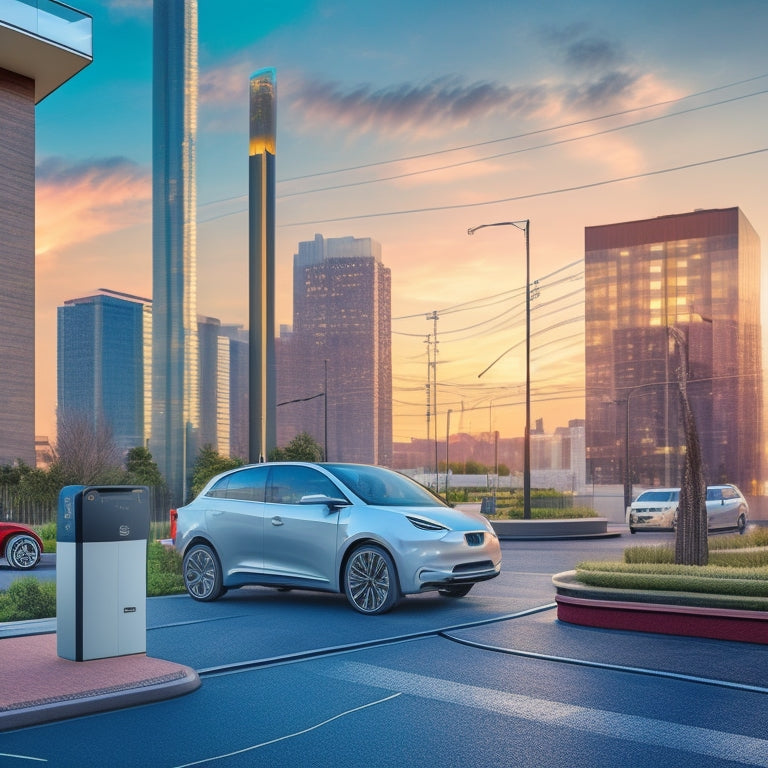
How to Install Smart EV Chargers in Apartments
Share
You'll start by evaluating your apartment's charging needs, examining the electrical infrastructure, parking spaces, and tenant preferences to determine the ideal number and type of chargers. Next, choose a smart charger that meets safety standards, is energy-efficient, and offers features like Wi-Fi connectivity and energy monitoring. Obtain necessary permits, prepare the installation site, and conduct a thorough site evaluation to identify potential obstacles or hazards. Install the charger, connect it to the electrical supply, and configure network connectivity. Finally, test and commission the system, and plan for ongoing maintenance to guarantee your smart EV chargers operate safely and efficiently - and that's just the beginning of your expedition to creating a seamless charging experience for your tenants.
Key Takeaways
- Assess apartment charging needs by evaluating electrical infrastructure, parking spaces, and tenant preferences to determine the ideal number and type of chargers.
- Choose the right smart charger by considering charger type, power capacity, installation costs, user preferences, and key features like Wi-Fi connectivity and energy monitoring.
- Obtain necessary permits, including electrical and building permits, to ensure compliance with local ordinances and regulatory requirements.
- Prepare the installation site by conducting a thorough site evaluation, performing an electrical assessment, and taking precise measurements to identify potential obstacles or hazards.
- Install the smart charger by following the manufacturer's instructions, adhering to local electrical codes, and considering factors like charger location, ventilation, and clearance.
Assessing Apartment Charging Needs
Most apartment buildings have a unique set of requirements when it comes to installing smart EV chargers, and evaluating these needs is vital to a successful installation.
You'll need to assess the electrical infrastructure, available parking spaces, and charging preferences of your tenants. Installing EV charging stations can increase property value attracts eco-conscious tenants, attracting eco-friendly residents and enhancing marketability.
Collecting tenant feedback is important to understanding their needs, such as charging speed and accessibility. You should also consider the building's energy load and potential upgrades required to support the increased demand.
By gathering this information, you can determine the ideal number and type of chargers needed, ensuring a seamless and convenient charging experience for your tenants.
This thorough assessment will help you create a customized solution that meets the specific needs of your apartment building and its residents.
Choosing the Right Smart Charger
When selecting a smart EV charger for your apartment, you'll need to evaluate the charger type that best fits your needs, whether it's a Level 2 or DC Fast Charger.
You'll also need to identify the key features required, such as Wi-Fi or cellular connectivity, energy monitoring, and smart grid integration.
Additionally, you must assess the installation space, taking into consideration the charger's physical dimensions, cable management, and ventilation requirements.
Moreover, it's crucial to evaluate solar-powered charging solutions that can reduce your carbon footprint and energy costs.
Charger Type Considerations
With the apartment's electrical infrastructure assessed, you're ready to choose the right smart EV charger for your installation.
Now, it's important to take into account charger type. You'll want to confirm charger compatibility with your vehicle and the building's electrical system.
Assess power capacity, taking into account the maximum power output required for efficient charging. It's also vital to evaluate the potential fuel cost savings and environmental benefits Key Takeaways of switching to an EV, as this will impact your charger selection.
Installation costs, user preferences, and future proofing options also come into play. Look for chargers that meet stringent safety standards and offer energy efficiency.
Research brand reputation, reading reviews and ratings to verify you're getting a reliable charger.
Key Feature Requirements
As you investigate the world of smart EV chargers, understanding the key feature requirements becomes crucial to selecting the right charger for your apartment's unique needs.
You'll want to evaluate energy efficiency, as it directly impacts your electricity costs and carbon footprint. Look for chargers with high power factors and efficient conversion rates.
Additionally, prioritize user accessibility features, such as touchless payment systems, mobile app control, and voice assistant integration. These features guarantee a seamless charging experience and provide you with the freedom to manage your charging sessions remotely.
Furthermore, examine chargers with built-in scheduling capabilities, allowing you to optimize your charging sessions during off-peak hours, additionally reducing your energy costs.
By integrating solar-powered EV chargers, you can contribute to a greener environment and reduce your reliance on the grid.
Moreover, smart chargers can help you take advantage of load shifting to reduce peak demand on the grid and lower your energy bills.
Installation Space Needs
Now that you've assessed the key features required for your apartment's smart EV charger, it's time to contemplate the physical space where the charger will be installed.
You'll need to verify the installation space can accommodate the charger's size and electrical capacity. Measure the available space to determine if it can fit a wall-mounted or floor-standing charger.
Consider the cable management system, as it will impact the overall installation space needs. Additionally, confirm the electrical capacity of your apartment's electrical infrastructure to ascertain it can support the charger's power output.
A charger with a higher power output will require more electrical capacity, so it's vital to choose a charger that aligns with your apartment's electrical capabilities.
To minimize energy losses and reduce operating costs, consider selecting energy-efficient charging equipment that meets your energy needs.
Proper installation and labor costs can also be reduced by conducting thorough site assessments and prefabricating components.
Obtaining Necessary Permits
Two essential permits you'll need to obtain before installing smart EV chargers in your apartment are the electrical permit and the building permit.
These permit types guarantee your installation meets local ordinances and building codes. You'll need to maneuver the application process, which involves submitting plans and paying fees.
Be aware of regulatory requirements, such as obtaining approval from your landlord or homeowner's association. Consider timeline constraints, as permit approval can take several weeks.
Don't forget to notify your tenants, if applicable, about the installation.
When selecting a contractor, verify they're familiar with local regulations and can facilitate the permit process.
Preparing the Installation Site
With permits in hand, you're ready to prepare the installation site for your smart EV charger.
Begin by conducting a thorough site evaluation to identify any potential obstacles or hazards. This includes evaluating the charger's proximity to electrical panels, circuit breakers, and other electrical infrastructure.
Next, perform an electrical assessment to determine the available power supply and verify it can support the charger's maximum load. This may involve checking the electrical service entrance, main electrical panel, and branch circuits.
Take precise measurements and notes to guarantee a smooth installation process. By doing so, you'll confirm a safe and efficient installation that meets all electrical codes and standards.
Installing the Smart Charger
You'll now focus on installing the smart charger, which requires careful consideration of the charger's location to guarantee optimal performance and safety.
You'll need to follow a series of steps to properly install the charger, including mounting the unit and connecting it to the electrical infrastructure.
Next, you'll connect the charger to the electrical grid and configure it for operation, a process that demands attention to detail to guarantee a safe and efficient charging experience.
Charger Location Considerations
Installing a smart EV charger in an apartment requires careful consideration of the charger's location to guarantee safe, efficient, and convenient charging.
You'll want to make sure the charger is easily accessible, especially if you plan to charge your vehicle frequently.
When selecting a location, consider the following factors:
-
Outdoor accessibility: Make sure the charger is installed near a parking spot, making it easy to plug in your vehicle.
-
Proximity to the power supply: The charger should be close to the electrical panel to minimize the length of cable runs and reduce installation costs.
-
Ventilation and clearance: The charger requires adequate ventilation and clearance from flammable materials to prevent overheating and electrical hazards.
Charger Installation Steps
Now that you've determined the ideal location for your smart EV charger, it's time to begin the installation process. Make certain you've selected a charger compatible with your electric vehicle and the apartment's electrical infrastructure. Verify the charger's power output matches your vehicle's charging capacity to prevent any damage.
| Step | Task | Considerations |
|---|---|---|
| 1 | Mount the charger | Make certain proper ventilation and clearance from flammable materials |
| 2 | Connect to electrical supply | Check installation costs and make certain compatibility with existing wiring |
| 3 | Install networking components | Configure Wi-Fi or cellular connectivity for remote monitoring and control |
Follow the manufacturer's instructions and local electrical codes to complete the installation. If unsure, consider hiring a licensed electrician to make certain a safe and compliant installation.
Charger Connection Process
As the charger's electrical components come into play, connecting it to the power supply becomes a crucial step.
You'll need to guarantee a secure and efficient connection to provide a seamless user experience.
To connect the charger, follow these steps:
-
Verify the electrical requirements: Confirm the charger's voltage and amperage ratings match the building's electrical infrastructure to avoid overheating or electrical shock.
-
Run the charging cable: Route the cable from the charger to the power supply, guaranteeing it's securely fastened and meets the charging infrastructure's specifications.
-
Test the connection: Power on the charger and verify it's functioning correctly, providing a safe and efficient charging experience for users.
Configuring Network Connectivity
Several smart EV charger units require a stable network connection to function effectively, and configuring network connectivity is an essential step in the installation process.
You'll need to make certain your charger is connected to a reliable network, either through Wi-Fi or Ethernet. Start by configuring the charger's network settings according to the manufacturer's instructions.
Next, implement network security measures, such as setting up a secure password and enabling encryption, to prevent unauthorized access.
If you encounter issues, perform connectivity troubleshooting by checking the charger's network status, restarting the device, and verifying your internet connection.
Testing and Commissioning
With your smart EV charger's network connection up and running, you can proceed to test and commission the unit. This critical step guarantees the charger operates safely, efficiently, and in compliance with regulations.
You'll need to perform the following tests:
-
System Testing: Validate the charger's performance, power management, and network integration to guarantee seamless functionality.
-
Safety Checks: Conduct thorough safety checks to identify potential hazards and assure user safety.
-
Compliance Verification: Verify that the charger meets all relevant regulations, standards, and industry requirements.
Through these tests, you'll gather significant user feedback, assess the charger's functionality, and make any necessary adjustments before finalizing the installation.
Ongoing Charger Maintenance
One essential aspect of guaranteeing your smart EV charger continues to operate efficiently and safely is ongoing maintenance. This includes routine inspections to identify potential issues before they become major problems, which can help extend the charger lifespan.
You'll also need to perform software updates to guarantee you have the latest features and security patches. User training is vital to guarantee residents understand how to use the charger correctly, and troubleshooting techniques can help you quickly resolve common issues.
Regular maintenance can help reduce costs and minimize downtime. Additionally, following safety protocols and considering the environmental impact of your charger can help you operate in an eco-friendly and responsible manner.
Frequently Asked Questions
Can I Install a Smart EV Charger in a Rented Apartment?
You're among the 80% of Americans who want to switch to electric vehicles, but wonder if you can install a smart EV charger in your rented apartment. You'll need to secure plug sharing agreements with your landlord and negotiate tenant agreements before proceeding.
Are Smart EV Chargers Compatible With All Electric Vehicle Brands?
You'll find that most smart EV chargers boast universal vehicle compatibility, thanks to their advanced charger features, such as SAE J1772 and CCS connectors, ensuring seamless charging for your ride, regardless of the electric vehicle brand you own.
How Long Does a Typical Smart EV Charger Installation Take?
You'll find that a typical smart EV charger installation takes around 2-4 hours, depending on the complexity of the installation process and various time factors, such as permit acquisition and electrical infrastructure assessments.
Do Smart EV Chargers Require a Dedicated 240-Volt Circuit?
You'll need to verify your smart EV charger has a dedicated 240-volt circuit, just like your electric oven or dryer, to meet electrical code compliance and assure safe, efficient charging, giving you the freedom to charge your vehicle without worry.
Can I Use a Smart EV Charger With a Solar Panel System?
You can utilize solar energy integration with your smart EV charger, optimizing charging efficiency by leveraging excess energy generated during the day to power your vehicle, reducing your reliance on the grid and increasing your freedom.
Related Posts
-

Why Choose Cool Roofs in Scorching Climates?
You opt for cool roofs in scorching climates because they enable you to reclaim control over your energy consumption ...
-

3 Best Solar-Powered Biodegradable Accessories for Your Home
You're taking a significant step towards a more sustainable lifestyle by incorporating solar-powered biodegradable ac...
-

10 Green Waste Solutions Every Homeowner Should Know
You can make a significant impact on the environment by implementing green waste solutions at home. Consider composti...


